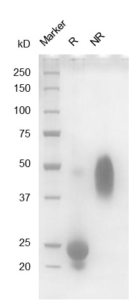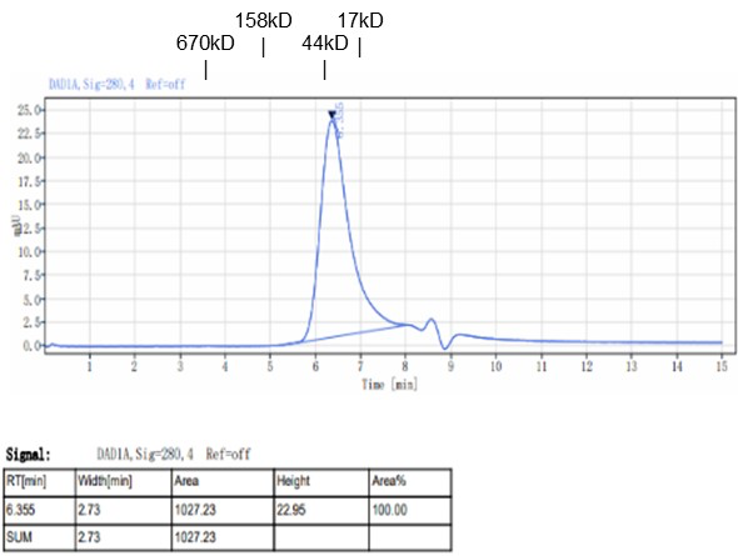hVEGF165(27-191)-His
Description
Vascular endothelial growth factor (VEGF) is active in angiogenesis, vasculogenesis and endothelial cell growth. It belongs to the platelet-derived growth factor (PDGF) family, characterized by eight conserved cysteine residues and a cystine knot structure. VEGF induces endothelial cell proliferation, promotes cell migration, inhibits apoptosis and increases blood vessel permeability. It is induced by hypoxia and cytokines such as IL1, IL6, IL8, oncostatin M and TNFa, and often exists as a disulfide-linked homodimer. Humans express alternately spliced isoforms of 121, 145, 165, 183, 189 and 206 amino acids in length. The most abundant and potent variant is VEGF165, followed by VEGF121 and VEGF189. Isoforms other than VEGF121 contain basic heparin-binding regions and are not freely diffusible. Although the highest affinity of VEGF is for binding to VEGFR1, VEGFR2 appears to be the primary mediator of VEGF angiogenic activity. VEGF165 binds the semaphorin receptor, Neuropilin-1 (NRP1) and promotes complex formation with VEGFR2. It is the only splice variant that binds to co-receptors NRP1 and NRP2 to enhance VEGFR2 signaling. Binding of VEGF165 to VEGFR1 and VEGFR2 leads to activation of the PI3K/AKT, p38 MAPK, FAK and paxillin. In adults, VEGF functions mainly in wound healing and the femail reproductive cycle. Pathologically, it is involved in tumor angiogenesis and vascular leakage. Circulating VEGF levels correlate with activity in autoimmune diseases such as reheumatoid arthritis, multiple sclerosis and systemic lupus erythematosus. In addition to stimulating tumor blood vessel formation, VEGF has immunosuppressive effects by acting on dendritic cells to block their antigen-presenting and T cell stimulatory functions. Combining VEGF targeting with other immune checkpoint ligands or receptors may prove more effective in immunotherapy approaches to certain cancer types. In differentiation protocols for stems cells, VEGF is commonly added to drive the conversion of induced pluripotent stem cells into hematopoietic progenitor cells for generating NK cells. It has also been used to transform intermediate mesoderm into kidney glomerular podocytes or stem cell-derived liver spheres.
Product name | hVEGF165(27-191)-His |
Species | Homo sapiens |
Expression system | HEK293 |
Buffer | PBS, pH 7.4 |
Delivery condition | Dry ice (-80°C) |
Delivery Time | 1 week if in stock; 4 weeks if production needed |
Storage condition | Store at -80°C |
Brand | BioMetas |
Applications | Angiogenesis/Cardiovascular Research, Cancer Biomarkers, Cancer Research, Immune Checkpoint, Immune System, Immunotherapy, Inflammation Research, Neurobiology Research, Stem Cells & Differentiation, Targeted Therapy, Transplantation Research, Wound Healing |
Aliases/Synonyms | VEGF-A, VEGFA, vascular permeability factor, VPF, RP1-261G23.1, MGC70609, MVCD1 |
Reference | |
Note | For research use only. Not suitable for clinical or therapeutic use. |
Size | 1mg, 5mg, 10mg, 50mg, 100mg |
Brand | BioMetas |
Product type | Antigen |
Expression system | HEK293 |
Applications | Angiogenesis/Cardiovascular Research, Cancer Biomarkers, Cancer Research, Immune Checkpoint, Immune System, Immunotherapy, Inflammation Research, Neurobiology Research, Stem Cells & Differentiation, Targeted Therapy, Transplantation Research, Wound Healing |
Contact Us for a Quote!
Data Gallery
Fig. 1.) 4-20% SDS-PAGE analysis
Recombinant protein was visualized by Coomassie Brilliant Blue R250 staining.

Fig. 2.) SEC-HPLC analysis
Column: Superdex 200 Increase 5/150 GL
Running buffer: 2xPBS, pH 7.4
